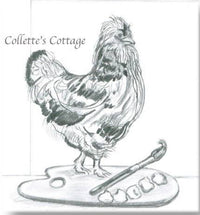
Artisan Enhancements - Easy Crackle
Easy Crackle by Artisan Enhancements ® is bio-based, hypo-allergenic, low odor, NO VOC, and environmentally sustainable. Easy Crackle is a thin medium that allows water based paints or plasters to create fine subtle, classic chipped/crackled effects. Easy Crackle the sophisticated, aged, antiqued look of weathered paint and/or plaster.
Recommended Use: Easy Crackle is formulated for application on cabinets, furniture, and walls. Ideal on previously painted or sealed surfaces. Easy Crackle is NOT intended to crack latex or oil paint. Easy Crackle is formulated to be used with water based flat paint, such as a Chalk Paint® or other clay/mineral paints.
Application:
Prepare the sealed base surface. The base surface or base coat is the layer that will be seen through the cracks of the topcoat layer of plaster or paint. If an undercoat or base coat of paint is desired, apply the paint and allow the paint to completely dry before applying the Easy Crackle layer. Easy Crackle can also be applied to stained or natural sealed wood surfaces. If working on a surface that will not be base coated with paint, make sure the surface has been previously sealed. If the surface is unsealed, seal the surface first with Clear Topcoat Sealer by Artisan Enhancements ®.
Brush or roll-on a liberal coat of Easy Crackle to the prepared/base coated surface. Use light pressure when brushing or rolling Easy Crackle to avoid over working the crackle medium as it begins to dry. Easy Crackle will go on “milky” but will dry clear, allow the Easy Crackle to dry thoroughly before proceeding.
Apply a topcoat of plaster or paint to the dry Easy Crackle layer. The topcoat is the layer where cracks will appear once dried. For easy plaster applications, use the Color Shaper by Artisan Enhancements ® or a trowel to apply plaster topcoats for thick and heavy crackled finishes. For paint applications, use a brush or roller to apply the paint topcoat. Cracks will appear as soon as the topcoat of plaster or paint starts to dry. To eliminate early appearing cracks accidently being plastered or painted over, avoid excessive pressure and don’t overwork the topcoat. Once top coat is dry seal the surface with Clear Finish by Artisan Enhancements ® (for additional sheen) or Clear Topcoat Sealer by Artisan Enhancements ® (for high use and exterior surfaces). Follow the recommended instructions for Clear Topcoat Sealer and Clear Finish cure times before using the surface.
- To achieve a natural irregular crackle finish: On a prepared surface apply Easy Crackle using a round brush (we recommend the Small Round Brush by Artisan Enhancements ®). Allow Easy Crackle to dry until clear, then using light pressure, stipple the topcoat of paint. Allow surface to fully dry then seal with Clear Finish by Artisan Enhancements ® (for additional sheen) or Clear Topcoat Sealer by Artisan Enhancements ® (for high use and exterior surfaces).
- To create a linear crackle effect: Apply base coat of paint using linear strokes and allow to fully dry. Using a chip brush and light pressure apply Easy Crackle to the painted surface using linear strokes. Once crackle medium is dry (Easy Crackle dries clear), apply a liberal coat of paint in linear strokes. Be sure to maintain light pressure. Allow the crackled surface to fully dry then seal with Clear Finish by Artisan Enhancements ® (for additional sheen) or Clear Topcoat Sealer by Artisan Enhancements ® (for high use and exterior surfaces).
- For added texture, Easy Crackle can be used with Fine Stone by Artisan Enhancements ® or VP Antico by Artisan Enhancements®.
Helpful Hints – What to do if cracks do not appear?
If cracks do not appear after the topcoat of paint is completely dry, one of the following reasons could be the cause of the missing crackle effect:
– The Easy Crackle medium was overworked when being applied and therefore wiped back leaving not enough crackle medium on the surface.
– Not enough Easy Crackle medium was applied between the base surface/base coat and the topcoat.
– Not enough paint for the paint topcoat layer was used and therefore there wasn’t enough paint to crack.
– Topcoat layer was overworked and cracks were filled in by passing over cracks too many times.
If cracks do not appear after the first attempt reapply Easy Crackle with a heavier hand or use 2 coats of Easy Crackle if desired. Repeat the application of paint topcoat process based on desired finish.
